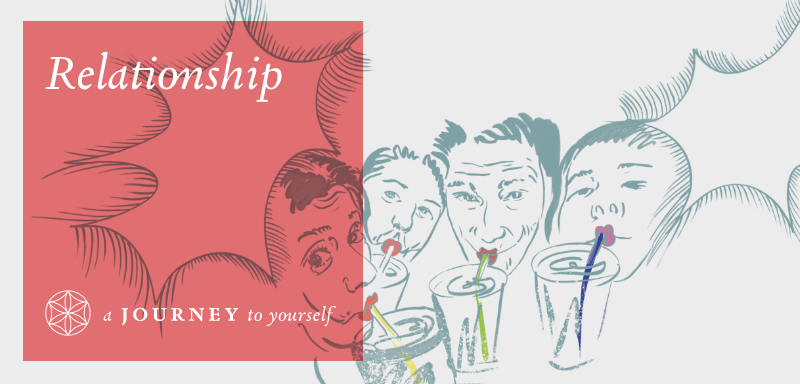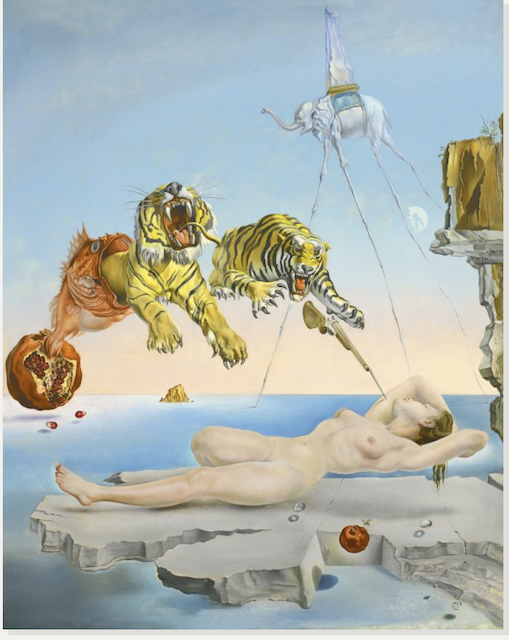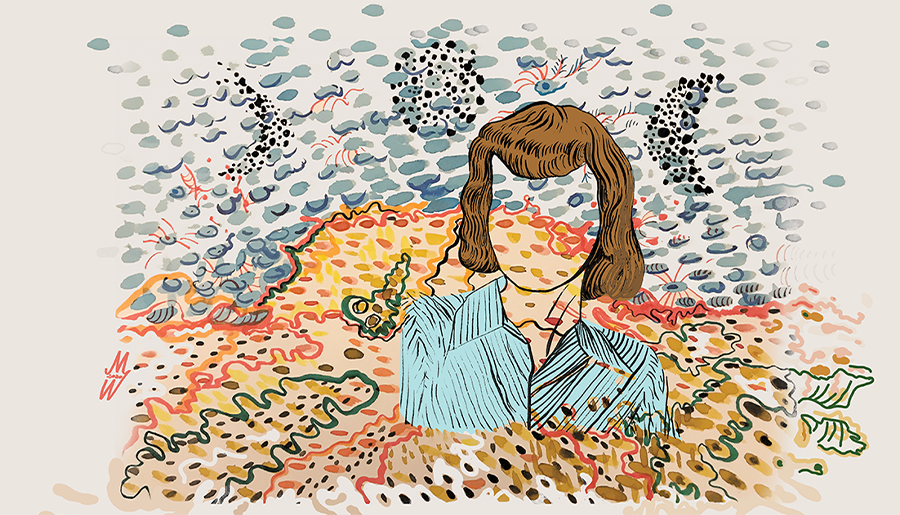Dreams are another category of imagination. Dreams have fascinated people since the dawn of time. The Egyptians believed that they were descended from the gods, the Greeks used them to heal diseases, the Romans, Aztecs and Mayans even had specially designated people who were engaged in studying dreams. There were even dream temples. People in all corners of our globe have tried and are trying to understand them. In almost every culture, dream books were created that gave specific meaning to dreams and their elements, and religions looked for a way of communicating with God in them. The analysis of dreams was also undertaken by psychotherapists such as Sigmund Freud or C.G. Jung.
In this article you will learn what:
- A dream is.
- Its phases are (NREM and REM).
- Is a liminal dream (hypnagogia and hypnopompia).
- The Aboriginal concept of “dream time” is.
It is hardly surprising when you think that each of us spends a third of our lives sleeping, most of which we dream about. Most often, however, none of us take our dreams seriously, unless we dream of something significant. On a daily basis, however, we do not delve into them and rather ignore them, treating them as a cluster of chaotic thoughts and images.
Dreams are the most unique and intriguing aspect of the sleeping process.
Sleep is essential for your life and the proper course of mental processes. It saves the body’s energy, affects the hormonal balance, consolidates memory, stimulates neurons, and affects concentration. In order to get enough sleep, we should sleep at night, because then our body rests best. This is how our body works by secreting melatonin, which is the hormone responsible for the feeling of sleepiness produced by the pineal gland. Proper sleep should last about 8 hours. Long-term lack of sleep causes a decrease in our body’s immunity, fatigue, mood disorders, reduced concentration and may even lead to death.
Most of us view sleep primarily as a physiological function of the body, as a bioelectrical activity in the brain. We treat it this way because we are masters of cutting ourselves off from nature, from our inner voice, and we consider ourselves better and wiser, and in fact, we just drown out the world.
In the West, however, more and more specialized institutions for studying sleep are emerging, pioneered by the discovery of a phase of sleep called REM.
Sleep phases.
There are two phases during sleep:
NREM (non REM) – deep sleep. A phase characterized by slow eye movements. Every dream begins with it. The duration of this phase usually lasts about 90 minutes and is also divided into smaller phases, ranging from calm, relaxation, naps to deep sleep. In this phase, the brain switches from working on alpha waves to working on theta waves, then incoherent thoughts appear in our head and our awareness of external stimuli begins to decline. In the next stage, our eyeballs stop moving and our reaction to external stimuli disappears. Then the brain goes into delta waves and images appear. In this phase of sleep, the brain turns off most functions or changes their intensity.
REM (Rapid Eye Movements) – shallow sleep, in which there are rapid eye movements and complete muscle relaxation, i.e. night paralysis. It takes 15 minutes. In this phase, vivid dream images appear, and the mind is directed to perceive the inner world. The cycle of the NREM and REM phases is repeated usually four or five times throughout the night. The closer to morning, the shorter the time spent in NREM and the longer the REM phase. The last, longest phase of REM sleep can sometimes last up to 45 minutes and we usually remember the sleep from this phase.
Dreams can occur at any stage of sleep.
According to the National Sleep Foundation, the US sleep education foundation, adults typically dream from four to six dreams, although they don’t remember all of them, because most people remember their last dream.
Dreams can be colored, black, and white mixed or in shades of gray. They include visual images, auditory illusions, tactile sensations, and movement sensations, although there are also static and imageless dreams. They can be good or bad (nightmares).
Dreams are a powerful tool for working on yourself that should not be taken lightly.
They are a combination of our memories and life experiences, recorded in our unconscious. They take you to other dimensions of life and allow you to communicate directly with your own soul. During sleep, the boundary between the outer and inner world disappears, both worlds begin to intertwine. Dreams are a gateway to other dimensions of life.
They can show you the secret wishes of your soul. Each night, if you just try to capture what they want to show you, you’ll find that they take you beyond what you already know. They are a way to reach a higher perspective. Through dreams, you can communicate with the deepest part of your psyche and know your inner needs. The soul, the real you, never sleeps. Through dreams, you can get the guidance you just need. Unfortunately, you often dismiss them unknowingly. Every night they give you a message that you are not able to hear in a busy time.
While dreaming, you can also travel without physically crossing your doorstep, even in time, because dreams are interdimensional. Dreams guide you towards your life goal, convey messages from deeper dimensions of reality. Every night we come out of our waking world we enter dreamland. Everyone dreams, although not all remember their dreams when they wake up. Dreams can be different. They are usually very realistic and can contain fantastic, erotic, or even surreal threads.

In addition to dreams, you also experience dream-like experiences called liminal sleep.
This is the moment when you fall asleep (hypnogogia) or wake up (hypnopompia). The first stage of the natural sleep cycle as your meandering consciousness mixes memory and thoughts with visionary images. It is characterized by dream visions and strange sensory phenomena. They appear when the brain waves jump from one state to the next. This state is a work of art created by our minds. Artists used this state to find inspiration for their works, for example, Salvador Dali, the famous Spanish surrealist painter.

Photo credits: © Salvador Dalí, Fundación Gala-Salvador Dalí / VEGAP, Madrid
Source: Museo Nacional Thyssen-Bornemisza, Madrid
https://www.museothyssen.org/en/collection/artists/dali-salvador/dream-caused-flight-bee-around-pomegranate-second-waking
Also, during the day, when you think you are fully aware and awake, you are also dreaming. Every 90 minutes you get a thought or idea. If you were careful you would receive this message from your subconscious. This state is called daydreaming. It is also the time when you run away from real life into dreams and visualize the future or the past during the day.
What is “dream time”?
In modern times, apart from psychotherapists or a few people dealing with this topic in their development of consciousness, only Australian Aborigines perceive sleep as a way to know your true self, a way to get in touch with your own soul. Dreams for them are as real as waking life. They believe that those with power can go beyond the dimensions of time and space through dreams. In their opinion, if something happened in a dream, it really happened. They believe that dreams answer questions about diseases, give advice, or allow contact with the souls of the dead.
In their opinion, the dream allows touching the essence of the world and the wisdom of the ancestors. Aborigines live what only philosophers do in the civilized world. Dreaming is the most important part of their culture. They believe that it determines life and is life itself. Their daily activities are dictated by dreams and visions in a trance.
The Aboriginal culture made a huge impression on you during your trip to Australia. Especially their contemporary art. At the AGSA contemporary art museum, you spent long hours studying Aboriginal art. You remember well that enchantment you had during your flight from Adelaide to Alice Springs when you admired a bird’s eye view of the Australian desert through your window. Suddenly you realized that these works of art are the result of their creators’ astral journeys. These images of the Australian desert seen from a bird’s eye view are nothing but their dream journal in your opinion.
Later, you bought a guide to modern Aboriginal art and learned about their concept of “Sleep Time”, a philosophy of life, based on the belief that earth and humans are interdependent, no concept of the past and the future, as they think everything is about the present, continuous growth and constant evolution. A modern man could learn a lot from Aborigines, especially about how to treat dreams.
The Silva Ultramind System
Thanks to our affiliate marketing colaboration you can also learn how to work with your dreams from one of Mindvalley’s programs – The Silva Ultramind System.
The Silva Ultramind System is a highly optimized framework for awakening your mind’s fullest potential by giving you reliable access to altered states of mind. Based on The Silva Method: a pioneering mind empowerment methodology founded in 1960 by Texan radio engineer Jose Silva (1914 – 1999), with over 6+ million students in 110 countries. Learn to access the Alpha level of mind for creative problem solving and healing, the Theta level for waking psychic and intuitive ability, and finally the Delta level while your conscious mind sleeps so that you can receive guidance from higher intelligence.
Source:
Susan McCullooch, Emily McCulloch Childs, „Contemporary Aboriginal Art”, McCulloch&McCulloch Australian Art Books, 2008.
https://www.sleepfoundation.org



